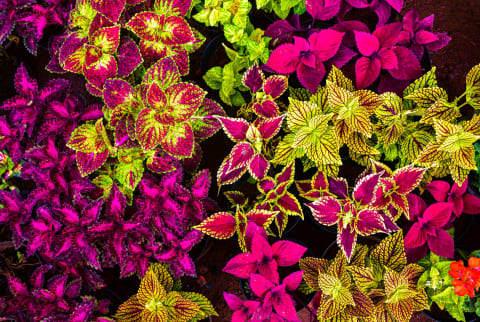Advertisement
An Intro To Coleus Plants + How To Keep Yours Looking Colorful & Bright


Already planning next year's garden? Coleus plants make for colorful and almost criminally low-maintenance additions to any outdoor display. These tropical beauties are quick to grow and easy to propagate from seed or cutting. Here's how to keep this plant looking its best and brightest, according to horticulture experts.
Coleus plants
Coleus is a genus of plants that comes from hot regions of the Old World, like Africa, Asia and the Pacific Islands, and Australia. They are native to tropical areas as well as more arid landscapes.
"They're in the mint family and share some features of the mint plant, like distinctive square stems and the ability to thrive just about anywhere," says Lindsay Pangborn, a gardening expert at Bloomscape.
Coleus plants have small, stacked leaves that can be bred to take on lots of attention-grabbing shades. This makes them popular picks for gardens and flower beds. As long as they're getting enough heat, these prolific growers can turn any yard into a rainbow of fun colors and patterns.
Plant overview:
- Sunlight needs: Full sun to partial shade
- When to water: When the top of its soil is dry to the touch
- Pros: Come in many colorful varieties, fast growers
- Cons: Sensitive to the cold
- Where to put them: In a sunny or shaded part of your garden, depending on the variety
- Pet-friendly? Toxic to cats and dogs according to the ASPCA
- Size: Can grow up to 18 to 48 inches tall in the garden
Different varieties
"Coleus has been a big focus for plant breeders for many years, so there are constantly new and improved varieties coming onto the market," Pangborn explains. Chris Satch, a plant specialist at Horti adds that they now come in colors ranging from red to pink, copper, neon green, dark green, purple, yellow, and more. Here are a few of the most popular:
- Burgundy Wedding Train: Deep burgundy leaves
- Sun Crimson Gold: Yellow and red leaves
- Lime Delight: Light green leaves
- Chocolate Symphony: Green and brown leaves
How to plant
Different coleus varieties have different lighting needs. The original Old World plants tend to do best in the partial shade, Pangborn says, while the newer cultivars have been bred to tolerate more sun. "Check the tag to determine whether the coleus you are buying has a strong preference for shade or is adaptable to sun," she recommends.
Once the last frost has passed and temperatures in your area are staying above 60 degrees Fahrenheit, you can plant your Coleus seedling or plant out in the garden. For full sun varieties, choose a spot that gets at least six hours of direct sun a day. Partial shade varieties can get away with three to six hours of direct sun daily. Place them in a spot that's shielded from the wind if possible.
After a few weeks in the ground, take your gardening gloves and a pair of shears and pinch back your flowers to encourage fuller growth. (Here's a guide to how that's done.)
While they're technically perennials, only those who live in USDA Hardiness Zones 11-13 (Hawaii and steamy regions in Southern California, Florida, Louisiana, Texas, and Arizona) will be able to keep their coleus plants alive year after year. That's because, once winter hits, most U.S. climates will be too cold for them.
You can either let your coleus die off once it gets cold or keep them as container plants and carry them inside to stay for the winter.
Indoors, aim to give them two to six hours of direct light daily and keep their surrounding temperatures around 65 to 75 degrees Fahrenheit. Don't place them near vents or drafty windows; remember, this plant hates the cold! Satch notes that a warm sun porch would be a good spot for it to ride out the winter.
Care tips
Once your coleus is situated in its sunny, warm spot, here's how to keep it happy and healthy. You'll know you're on the right track if its leaf colors stay bold and vibrant.
Water
Like most tropical plants, coleus plants like to be moist but not too wet. Let the top 2 to 3 inches of their soil dry out before giving them water.
The hotter and sunnier its surroundings, the more frequently your plant will need to be watered.
Soil
This plant tends to be pretty forgiving and should be fine in any soil that allows for some drainage.
Temperature
Coleus will not do well in temperatures much below 60 degrees Fahrenheit. Once temps in your area drop, bring the plant inside if you want it to last the winter.
Fertilizer
During the growing season, Pangborn notes that you can fertilize your coleus once a month using a balanced liquid or slow-release fertilizer. Though you might find your plant grows plenty quickly on its own during hot summer months, fertilizing can also help keep its leaves bright and vibrant.
Pruning
After a few weeks, you'll find that your coleus plants begin to grow tiny, oftentimes blue and white, flowers. Though it may feel counterintuitive, Pangborn says you'll want to snip those off—unless you're hoping to harvest its seeds.
"As soon as you see flower buds developing, pinch off the buds along with the top set or two of leaves," she explains. "Coleus flowers are not particularly attractive, and as soon as the plant produces buds, it's going to put all of its energy into flowering and developing seeds. That means energy is taken away from the colorful leaves, which will quickly become faded and tired-looking."
Common problems & how to fix them
- Droopy leaves and stems: Drooping, saggy leaves are usually a sign that your coleus is thirsty, Pangborn explains. This is common, especially during the bright sun of summertime. "If your plants look limp and sad, they can usually bounce right back," she says. If its soil feels dry, just give it a good soak and make a note to check in on it more frequently moving forward.
- Leggy appearance: If your plant is looking a little scraggly, with large areas of stems that are uncovered by leaves, cutting it down a bit will encourage a bushier appearance. "Pinch back the top set of leaves on each stem," Pangborn says. "This will force the plant to branch by pushing out a pair of new buds at each cut area and will overall make the plant look much more full. Bonus—the cuttings you just pinched off are super easy to propagate!" More on that below.
- Fading colors: If your coleus leaves are losing their bright hues, Satch notes that you might want to give it more light and/or fertilizer to encourage healthy growth.
How to propagate from seed or cuttings
Once you have a healthy coleus plant, it's easy to replicate it from seed or a stem cutting.
From seed:
- Allow your coleus to flower so you can harvest the seeds. Wait until the seed pods dry out and turn brown before gently cutting them off your plant.
- Put the pods in a paper bag and shake until small seeds emerge.
- Allow the seeds to dry in the bag for at least two weeks. Once they're dry, store them in a cool, dark place until you're ready to germinate them (four to six weeks before the last frost of the year).
- From there, place seeds on top of a pre-moistened seed-starting mix. You can also opt to use the mix from a seed starter kit. Press them gently into the soil and do not cover them, says Satch. If they're covered in soil, they won't get the light they need to germinate.
- From there, seeds will need plenty of light and heat. "Consider using a heat mat to speed up germination, and choose an area under a grow light or near a very sunny window," Pangborn recommends. "Spritz seeds often to keep them moist, or use a clear plastic cover that can trap humidity."
- Seeds will typically germinate in two to three weeks, Pangborn says. "Keep the seedlings well watered and under lots of light (16 hours per day is ideal) until they're ready to plant in the garden."
From cutting:
- Using a clean set of shears, cut a 4- to 6-inch stem off your healthy coleus plant. It should have a few leaves, and you'll want to remove the lowest set before you place it in a cup filled with a few inches of water. (You don't want any leaves sitting in the water.)
- Place the cutting in a spot that gets bright, indirect light, and wait for roots to form. It should take about two to three weeks.
- Once you see a bunch of little roots popping out of your cutting, plant it in well-draining soil.
The takeaway
Showstopping plants that are easy to care for and multiply, coleus are a gardener's dream. Just be prepared to lose them once cold weather hits—after taking a few stems or seeds for next year, of course.


















